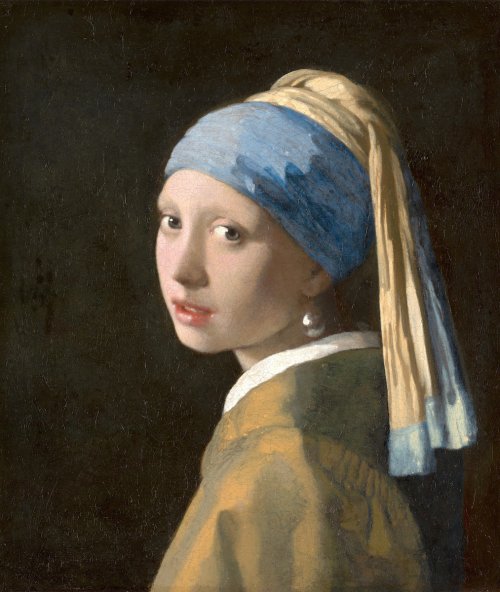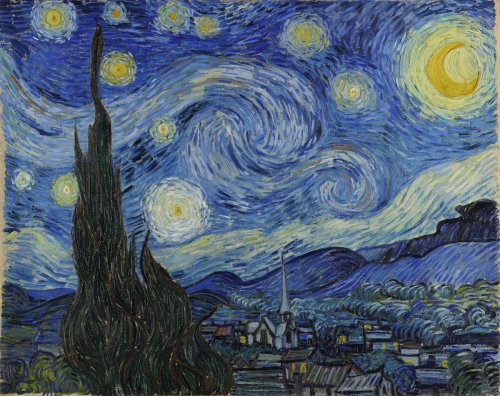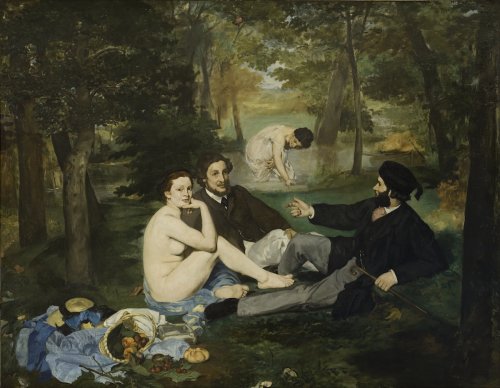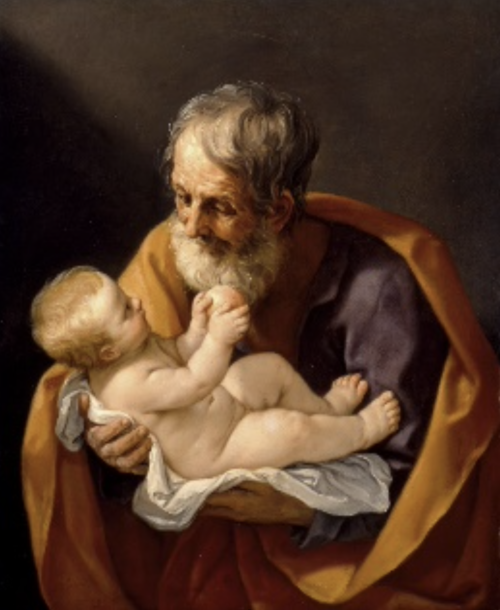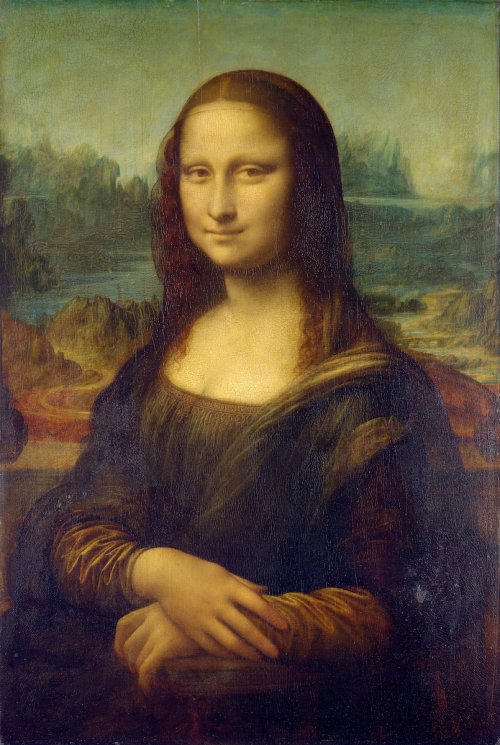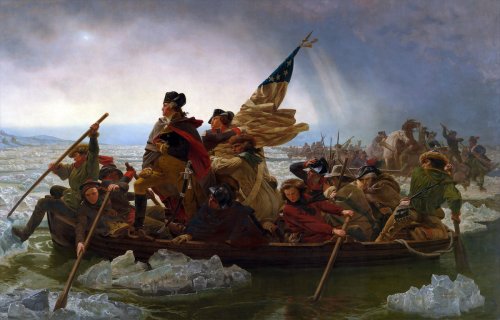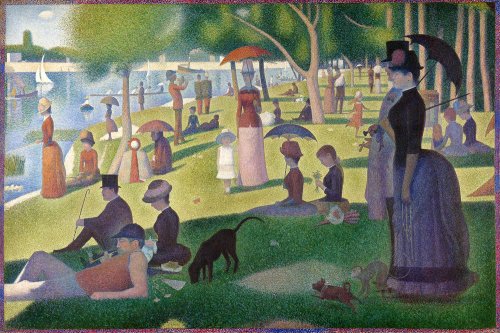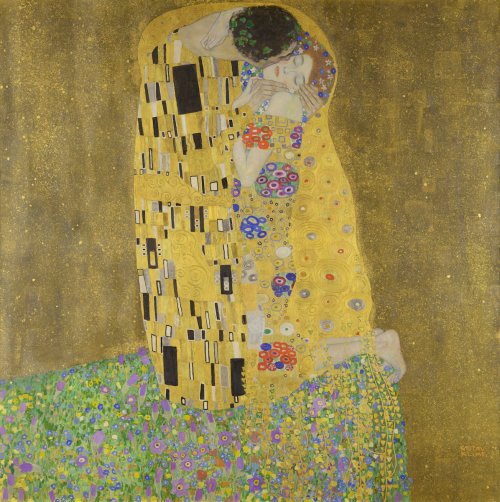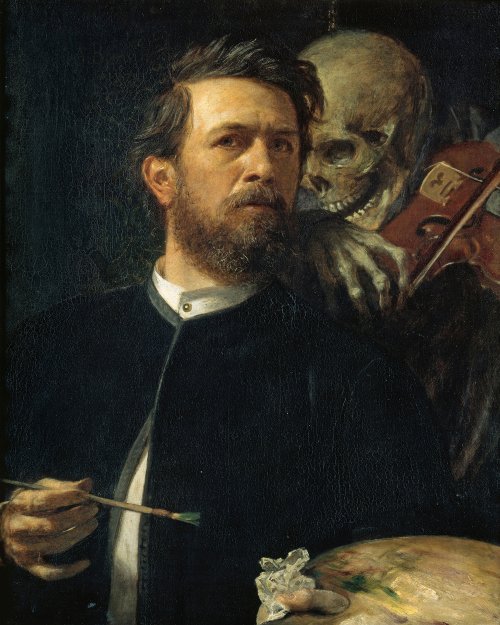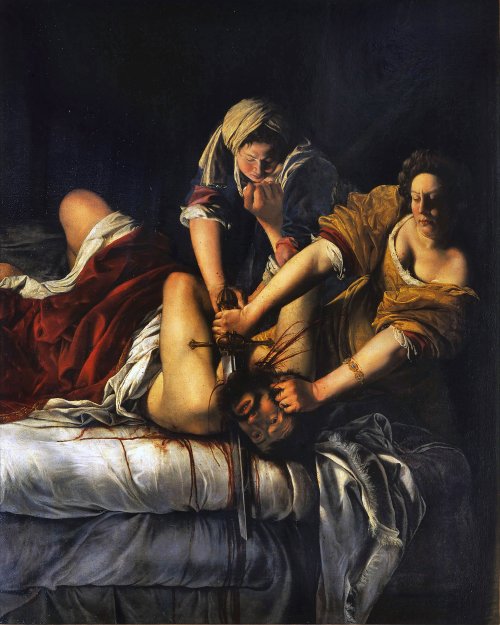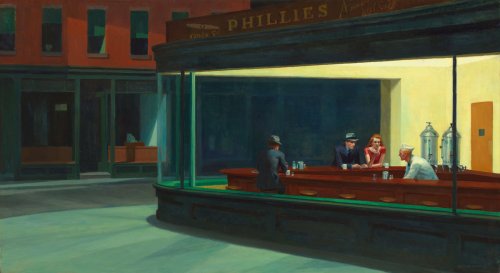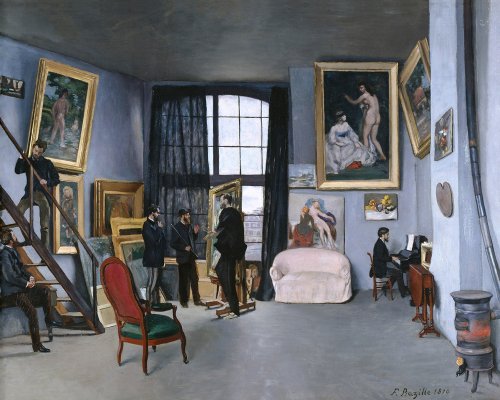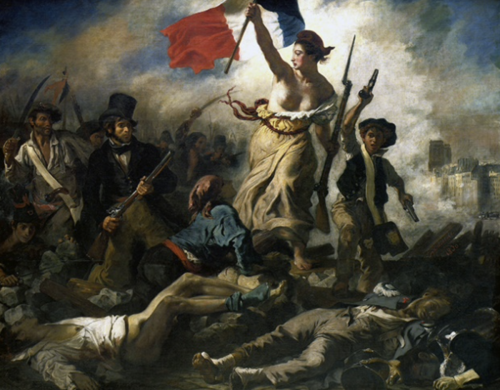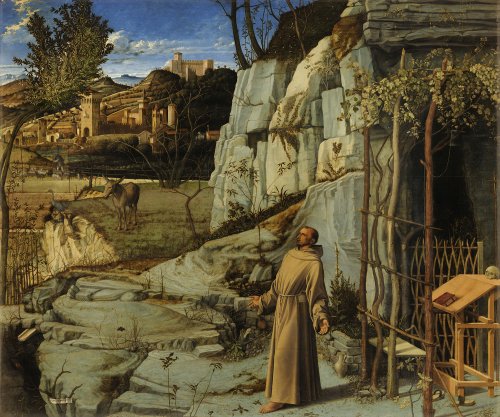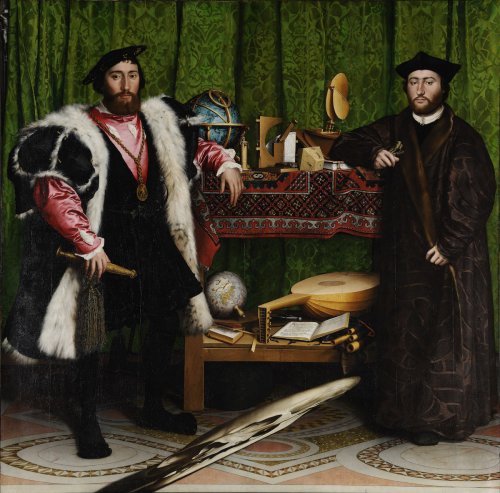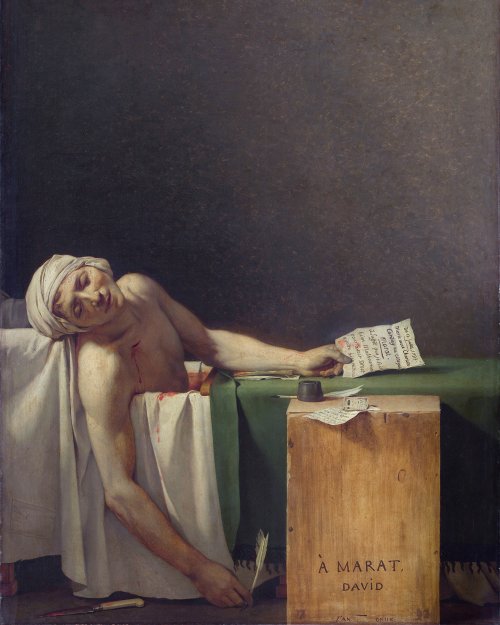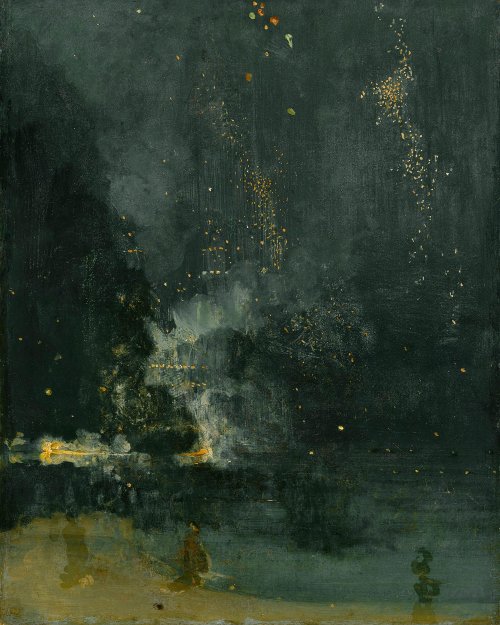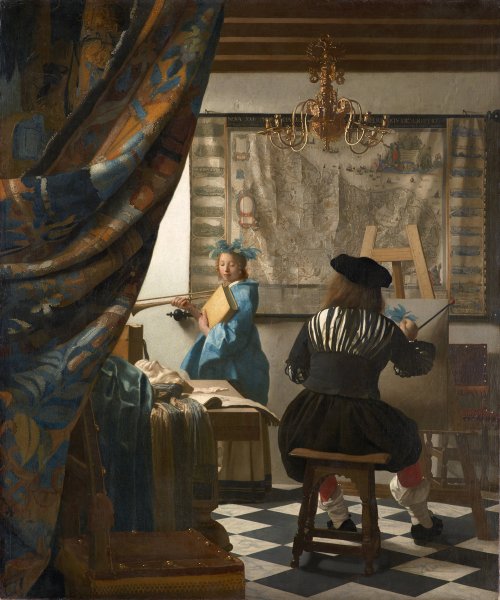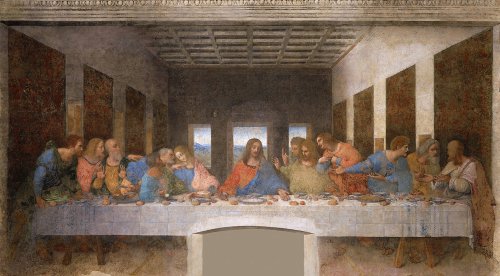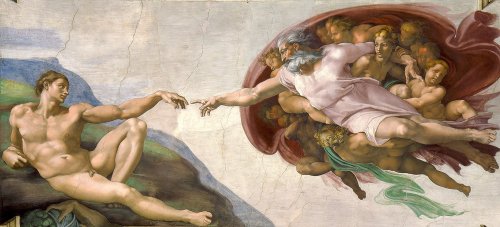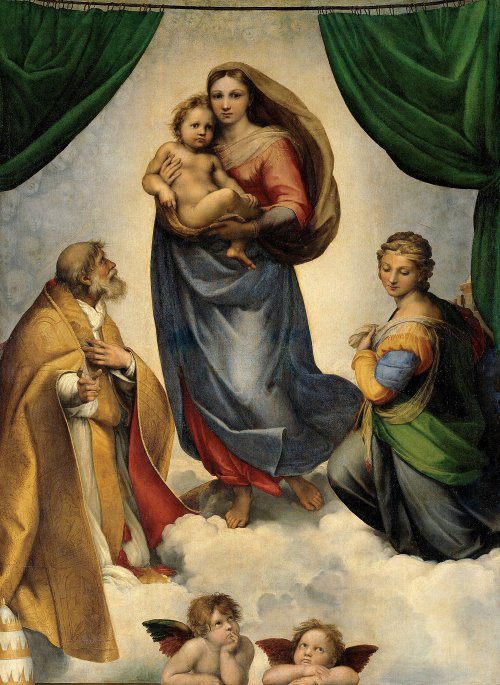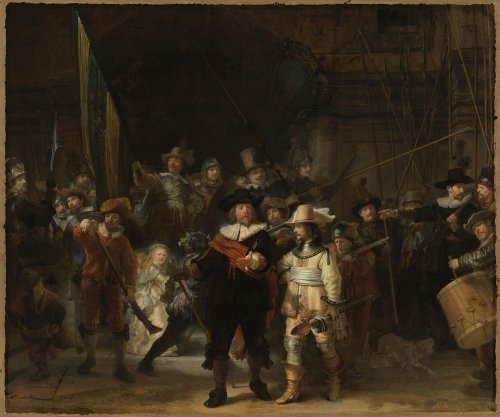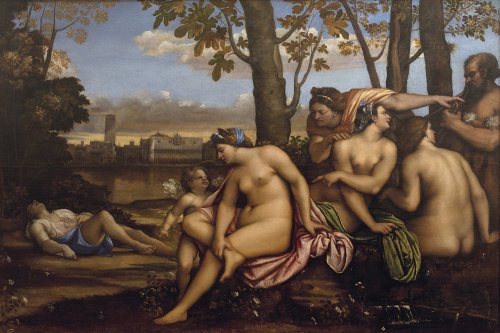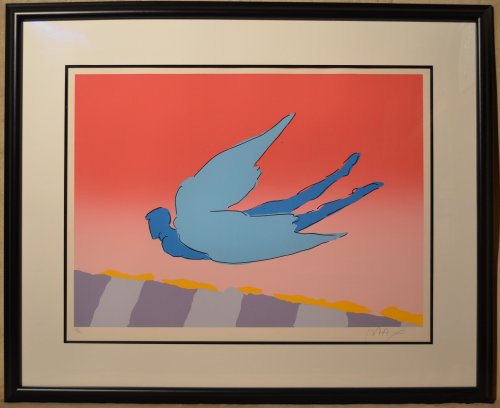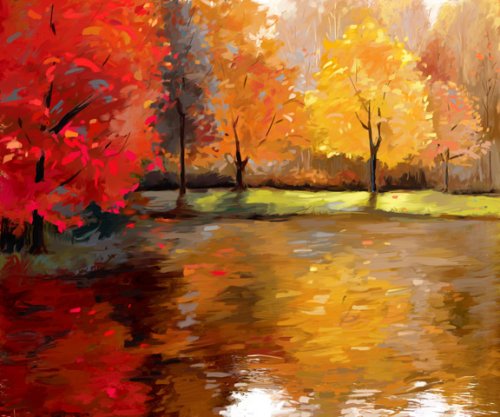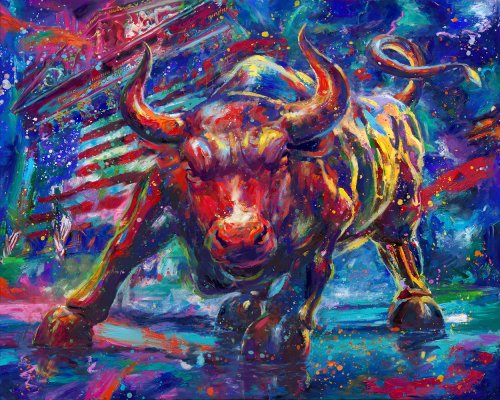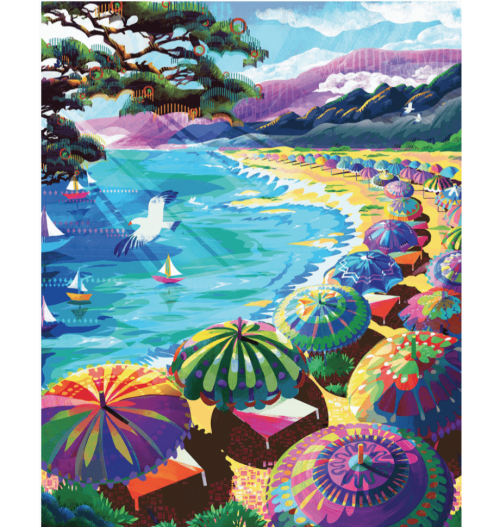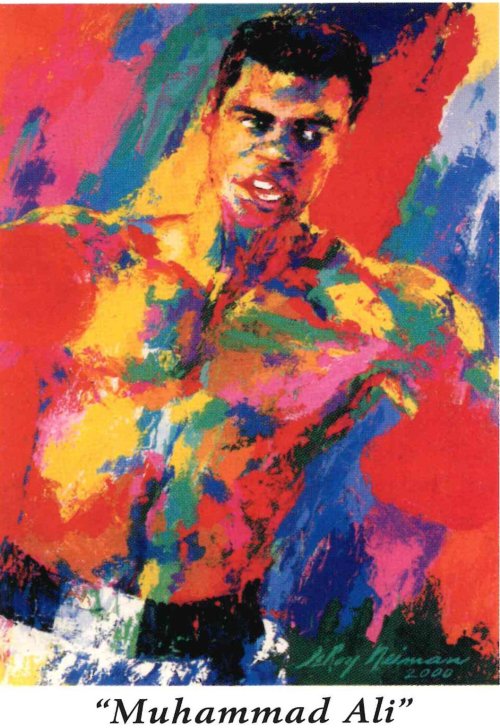Welcome to our World Heritage Art Treasury (W.H.A.T.) paintings collection. Immerse yourself in the captivating world of famous oil painting reproductions meticulously crafted by skilled artists. Each masterpiece is an authentic oil painting reproduction that reflects the superb quality and artistry of the original work.
-
***AUG 22 RELEASE DATE*** Girl with a Pearl Earring (Dutch: Meisje met de Parel) is an oil painting by Dutch Golden Age painter Johannes Vermeer. Going by various names over the centuries, it became known by its present title towards the end of the 20th century after the earring worn by the girl portrayed there. The work has been in the collection of the Mauritshuis in The Hague since 1902.
The work is oil on canvas and is signed “IVMeer” but not dated. It is estimated to have been painted around 1665. After the most recent restoration of the painting in 1994, the subtle color scheme and the intimacy of the girl’s gaze toward the viewer have been greatly enhanced.
-
The Starry Night is a post-impressionist oil-on-canvas painting by the Dutch Post-Impressionist painter Vincent van Gogh. Painted in June 1889, it depicts the view from the east-facing window of his asylum room at Saint-Rémy-de-Provence, just before sunrise, with the addition of an imaginary village. Widely regarded as Van Gogh’s magnum opus, The Starry Night is one of the most recognizable paintings in Western art.
In the aftermath of the 23 December 1888 breakdown that resulted in the self-mutilation of his left ear, Van Gogh voluntarily admitted himself to the Saint-Paul-de-Mausole lunatic asylum on 8 May 1889. The Starry Night was painted mid-June by around 18 June, the date he wrote to his brother Theo to say he had a new study of a starry sky. It has been in the permanent collection of the Museum of Modern Art in New York City since 1941.
The piece symbolizes Van Gogh’s deteriorating mental state and is estimated to be worth over 100 million dollars.
-
Le Déjeuner sur l'herbe / The Luncheon on the Grass – originally titled Le Bain (The Bath) – is an impressionist oil on canvas painting by Édouard Manet created in 1862 and 1863.
It depicts a female nude and a scantily dressed female bather on a picnic with two fully dressed men in a rural setting. Rejected by the Salon jury of 1863, Manet seized the opportunity to exhibit this and two other paintings in the 1863 Salon des Refusés, where the painting sparked public notoriety and controversy. The artwork broke away from the classical view that art should obey established conventions and sought to achieve timelessness.
The work is now in the Musée d’Orsay in Paris. A smaller, earlier version of the image is currently exposed at the Courtauld Gallery, London.
-
This intimate portrayal of Joseph demonstrates Reni’s skill through his rendering of the foster father of Christ as a simple man tenderly holding his infant son. The fruit held by infant Jesus reminds us of the fall of man in Eden and the fruitfulness of redemption through the advent of Christianity.
He was the most famous Italian painter of his day, revered for the grace and naturalness of his serenely balanced compositions. Even referred to as “the divine Guido.”
Working during the Catholic Counter-Reformation in the seventeenth century, Reni depicted images of saints and holy figures in the humanized and accessible form Catholic leaders required. This intimate portrayal of Joseph demonstrates Reni’s skill through his rendering of the foster father of Christ as a simple man tenderly holding his infant son.
-
The Mona Lisa is a half-length portrait by Italian artist Leonardo da Vinci. Considered an archetypal masterpiece of the Italian Renaissance, viewed as “the best known, most visited, most written about, most sung about, and most parodied work of art in the world.” Its novel qualities include the subject’s enigmatic expression, the subtle modeling of forms, and atmospheric illusionism.
Identified to depict Italian noblewoman Lisa Gherardini, the wife of Francesco del Giocondo. He painted it in oil on a white Lombardy poplar panel. Leonardo never gave the painting to the Giocondo family, and later it is believed he left it in his will to his favored apprentice Salaì. Acquired by King Francis of France and is permanently displayed at the Louvre in Paris in 1797.
-
This painting by German-American artist Emanuel Leutze commemorates General George Washington’s crossing of the Delaware River with the Continental Army on December 25–26, 1776, during the American Revolutionary War. That action was the first move in a surprise attack and victory against Hessian forces at the Battle of Trenton in New Jersey on 26 December.
The flag depicted is an early version of the flag of the United States (the “Stars and Stripes”), the design of which did not exist at the time of Washington’s crossing. The flag’s design was first specified on the 14 June 1777, Flag Resolution of the Second Continental Congress. It flew for the first time on 3 September 1777, well after Washington’s crossing in 1776.
The original was part of the collection at the Kunsthalle in Bremen, Germany, and was destroyed in a bombing raid in 1942 during World War II. Leutze painted two more versions, with the smaller version of the two, which was auctioned this year and sold for $43 million.
-
Appraised at $650 million dollars, A Sunday Afternoon on the Island of La Grande Jatte (French: Un dimanche après-midi à l'Île de la Grande Jatte) is Georges Seurat's most famous work. Executed on a large canvas, it is a founding work of the neo-impressionist movement. Seurat’s composition includes several Parisians at a park on the banks of the River Seine. It is in the collection of the Art Institute of Chicago.
Seurat’s painting was a mirror impression of his painting, Bathers at Asnières, completed shortly before, in 1884. Whereas it is doused in light, almost every figure on La Grande Jatte appears to be cast in shadow, under trees, an umbrella, or another person.
In 1923, Frederic Bartlett was appointed trustee of the Art Institute of Chicago. He and his second wife, Helen Birch Bartlett, loaned their collection of French Post-Impressionist and Modernist art to the museum.
-
The Kiss (in German Der Kuss) is an oil-on-canvas painting with added gold leaf, silver, and platinum by the Austrian Symbolist painter Gustav Klimt. It was painted between 1907 and 1908, during the height of what scholars call his “Golden Period.” It was exhibited in 1908 under Liebespaar (the lovers), as stated in the exhibition catalog. Love, intimacy, and sexuality are common themes in Gustav Klimt’s works.
The painting depicts a couple embracing each other, their bodies entwined in elaborate, beautiful robes that were decorated in style influenced by the contemporary Art Nouveau style and the organic forms of the earlier Arts and Crafts movement. The painting now hangs in the Österreichische Galerie Belvedere museum in the Belvedere.
-
Judith Beheading Holofernes is a baroque-style painting of the biblical episode by Caravaggio, in which the widow Judith stayed with the Assyrian general Holofernes in his tent after a banquet and then decapitated him after he passed out drunk. The exhibition catalog (Skira, 2018, p88) also cites biographer artist Giovanni Baglione’s account that Genoa banker Ottavio Costa commissioned the work.
The deuterocanonical Book of Judith tells how Judith served her people by seducing and pleasuring Holofernes, the Syrian General. Judith gets Holofernes drunk, then seizes her sword and slays him: “Approaching to his bed, she took hold of the hair of his head” (Judith 13:7–8).
Currently located at the Galleria Nazionale d’Arte Antica at Palazzo Barberini, Rome, the artwork is the most pivotal part of the Book of Judith. It depicts a socially liberated woman who punishes masculine wrongdoing.”
-
Nighthawks is a 1942 American realism oil on canvas painting by Edward Hopper that portrays four people in a downtown diner late at night as viewed through the diner’s large glass window. The light coming from the restaurant illuminates a darkened and deserted urban streetscape.
It has been described as Hopper’s best-known work and is one of the most recognizable paintings in American art. It is suggested that Hopper was inspired by a short story of Ernest Hemingway’s, either “The Killers” (1927), which Hopper greatly admired, or the more philosophical “A Clean, Well-Lighted Place” (1933).
The scene was supposedly inspired by a diner (since demolished) in Greenwich Village, Hopper’s neighborhood in Manhattan. Hopper said the painting “was suggested by a restaurant on Greenwich Avenue where two streets meet”. Additionally, he noted that “I simplified the scene a great deal and made the restaurant bigger”.
-
Bazille's Studio (L'atelier de Bazille) is an 1870 painting by the French impressionist Frédéric Bazille in collaboration with Édouard Manet. It has been kept at the Musée d’Orsay in Paris since 1986. It shows the artist himself surrounded by his friends in his studio, including the painters Édouard Manet and Pierre-Auguste Renoir.
Bazille shared a studio on the Rue de la Condamine with Renoir from January 1868 to May 1870. The tall Bazille is center stage, holding a palette, having in his own words been “painted in by Manet.” On the right, Edmond Maître, a friend of Bazille, is seated at the piano under a Monet still life. Manet is talking to Bazille and Renoir is seated.
All the wall-mounted pictures surrounding are ones that were rejected at some time by the Salon and for which Bazille is expressing his support. This artwork is currently located at the Musee D’Orsay in Paris, France, and has yet to be appraised.
-
Liberty Leading the People is a painting by Eugène Delacroix honoring the July Revolution of 1830, which toppled King Charles X of France. A woman of the people with a Phrygian cap personifying the concept of Liberty leads a varied group of people forward over a barricade and the bodies of the fallen. She is holding the flag of the French Revolution – the tricolor, which again became France’s national flag after these events – in one hand and wielding a bayonetted musket with the other. The figure of Liberty is also viewed as an emblem of France and the French Republic, known as Marianne. The artwork is sometimes wrongly thought to depict the French Revolution of 1789. Delacroix depicted Liberty as a symbolic goddess figure and a vigorous woman of the people. The mound of corpses, and wreckage acts as a kind of pedestal from which Liberty strides, barefoot and bare-breasted, out of the canvas and into the viewer’s space.
Delacroix painted his work in the autumn of 1830. In a letter to his brother dated 21 October, he wrote: “My bad mood is vanishing thanks to hard work. I’ve embarked on a modern subject—a barricade. And if I haven’t fought for my country at least, I’ll paint for her.” Liberty Leading the People is exhibited in the Louvre in Paris.
-
St. Francis in Ecstasy (or St. Francis in the Desert) is a painting by Italian Renaissance master Giovanni Bellini, started in 1475 and completed around 1480. Bellini depicted the religious figure of St. Francis of Assisi in a landscape. The painting portrays Francis of Assisi, the Italian saint of the early 13th century, in an Italian landscape, stepping out in the sun from his cave, his figure anchoring the creamy celadon and golden-green landscape.
Bellini became sophisticated in his painting skill in the fifteenth century, the culmination of which is Saint Francis In Ecstasy. The moment is depicted in the painting is Saint Francis’s stigmatization on the mountain of La Verna. Bellini envisioned the stigmatization as a moment of human transformation into the divine.[7] The sun’s rays shine on St. Francis, symbolizing him as a Seraph-Crucifix in front of the sun, which indicates the suffering image of the Seraphim.
-
The Ambassadors is an oil on canvas painting of 1533 by Hans Holbein the Younger. Also known as Jean de Dinteville and Georges de Selve, it was created in the Tudor period, in the same year Elizabeth I was born. Speculations would suggest that Elizabeth’s mother, Anne Boleyn, then Queen of England, might have commissioned the painting as a gift for ambassador Jean de Dinteville, who is portrayed on the left in the painting. As well as being a double portrait, the artwork contains a still life of several meticulously rendered objects, the meaning of which is the cause of much debate. It incorporates a much-cited example of anamorphisms in painting. This painting displays the influence Early Netherlandish painting had on Holbein.
The most notable and famous of Holbein’s symbols in his work is the distorted skull placed in the bottom center of the composition. The skull, rendered in anamorphic perspective, another invention of the Early Renaissance, is meant to be a visual puzzle as the viewer must approach the painting from high on the right side or low on the left side to see the form as an accurate rendering of a human skull.
The Ambassadors has rested in London’s National Gallery collection since its purchase in 1890.
-
he Death of Marat, also known as “La Mort de Marat or Marat Assassiné” in French, is neoclassicism artwork at its best.
The 1793 painting by Jacques-Louis David depicts the artist’s friend and murdered French revolutionary leader, Jean-Paul Marat. One of the most famous images from the era of the French Revolution, David painted it when he was the leading French Neoclassical painter, a Montagnard, and a member of the revolutionary Committee of General Security. Created in the months after Marat’s death, the painting shows Marat lying dead in his bath after his murder by Charlotte Corday on 13 July 1793. Art historian T. J. Clark called David’s painting the first modernist work for “the way it took the stuff of politics as its material and did not transmute it.”
The painting is in the collection of the Royal Museum of Fine Arts of Belgium. A replica, created by the artist’s studio, is on display at the Louvre.
-
First shown at the Grosvenor Gallery in London in 1877, it is one of two modern impressionist artworks (the other being Nocturne in Black and Gold – The Firewheel) inspired by the Cremorne Gardens, a celebrated pleasure resort in London. One of his many works from his series of Nocturnes, it is the last of the London Nocturnes and is now widely acknowledged to be the high point of Whistler’s middle period. Whistler’s depiction of the industrial city park in The Falling Rocket includes a fireworks display in the foggy night sky. His detractors deemed the painting too slapdash, incomprehensible, and even insulting.
This priceless artwork is currently located at the Detroit Institute of Art in Michigan.
-
The Art of Painting, also known as The Allegory of Painting, or Painter in his Studio, is a 17th-century oil on canvas painting by Dutch painter Johannes Vermeer. Owned by the Austrian Republic and is displayed in the Kunsthistorisches Museum in Vienna.
Many art historians think it is an allegory of painting, hence the alternative title. Its composition and iconography make it the most complex Vermeer work, making it his second-largest work.
This canvas depicts an artist painting a woman dressed in blue posing as a model in his studio. Standing by a window and a large map of the Low Countries hangs on the wall behind. Signed to the right of the girl “I [Oannes] Ver. Meer”, but not dated. Most experts assume he executed it sometime between 1665/1668, but some suggest he could have created it as late as 1670–1675. The painting has only two figures, the painter and his subject, a woman with downcast eyes. Thought to be a self-portrait of the artist, some have suggested the young woman could be his daughter.
-
This painting by Leonardo da Vinci represents the scene of the Last Supper of Jesus with the Twelve Apostles, as it is told in the Gospel of John – specifically, the moment after Jesus announces that one of his apostles will betray him. This high renaissance artwork is one of the Western world’s most recognizable paintings and among Leonardo’s most celebrated works.
The work was commissioned as part of a plan of renovations to the church and its convent buildings by Leonardo’s patron Ludovico Sforza, Duke of Milan.
-
The Creation of Adam is a fresco painting by Italian artist Michelangelo valued at 300 million dollars, which forms part of the Sistine Chapel’s ceiling, painted c. 1508–1512. It shows the Biblical creation narrative from the Book of Genesis in which God gives life to Adam, the first man. Part of a complex iconographic scheme, and chronologically fourth in a series of panels portraying episodes from Genesis.
Michelangelo’s Creation of Adam is one of the most replicated religious artwork. In 1505, the newly elected Pope Julius II invited Michelangelo back to Rome. He was commissioned to build the Pope’s tomb, which was to include forty statues and be finished in five years. It took him 40 years to complete, and even then, it was still not completed to his satisfaction. During the same time, Michelangelo painted the Sistine chapel in 4 years.
-
The Sistine Madonna, also called the Madonna di San Sisto, is an Italian Renaissance oil painting by the Italian artist Raphael. The painting was commissioned in 1512 by Pope Julius II for the church of San Sisto, Piacenza, and probably executed c. 1513–1514. In the artwork, the Madonna, holding Christ Child and flanked by Saint Sixtus and Saint Barbara, stands on clouds before dozens of obscured putti, while two distinctive winged putti rest on their elbows beneath her.
The canvas was one of the last Madonnas painted by Raphael.
The painting was moved to Dresden in 1754 and is well known for its influence on the German and Russian art scenes.
-
The Night Watch (Dutch: De Nachtwacht), is a 1642 painting by Rembrandt van Rijn. It is in the collection of the Amsterdam Museum but is prominently displayed on a permanent loan to the Rijksmuseum, Amsterdam, and is the best-known painting in its collection. The Night Watch is one of the most famous Dutch Golden Age paintings.
He was known for the dramatic use of light and shadow (tenebrism) and motion perception in what would have traditionally been a static military group portrait. The painting was commissioned around 1639 by Captain Banning Cocq and seventeen members of his Kloveniers (civic militia guards). The artistic work was completed in 1642, at the peak of the Dutch Golden Age.
It depicts the eponymous company moving out, led by Captain Frans Banning Cocq (dressed in black, with a red sash) and his lieutenant, Willem van Ruytenburch (dressed in yellow, with a white sash). With effective use of sunlight and shade, Rembrandt leads the eye to the three most important characters among the crowd: the two men in the center (from whom the painting gets its original title) and the woman in the center-left background carrying a chicken.
-
The Birth of Venus is an early renaissance oil on canvas painting by the Italian artist Sandro Botticelli, executed during the mid-1480s. It depicts the goddess Venus arriving at the shore after her birth, when she had emerged from the sea fully grown (called Venus Anadyomene and often expressed in art). The painting is in the Uffizi Gallery in Florence, Italy.
As a depiction of a subject from classical mythology on a vast scale, The Birth of Venus was virtually unprecedented in Western art since classical antiquity, as was the size and prominence of a nude female figure in the Birth. It was thought that it was commissioned by the same member of the Medici family.
-
The Death of Adonis is a 1512 Italian renaissance oil on canvas painting by Sebastiano del Piombo, now in the Uffizi in Florence. It was produced initially for Agostino Chigi just after the artist’s arrival in Rome, summoned to assist Chigi in decorating the Villa Chigi. A 1520 inventory of the villa stated it contained “figures of more nude and beautiful women.” The work arrived in Florence in 1587 and was held at the Palazzo Pitti.
Discover the World Heritage Art Treasury (W.H.A.T.)
At the heart of the World Heritage Art Treasury (W.H.A.T.) lies a curated selection of museum-quality art reproductions. These fine art pieces capture the essence and beauty of renowned oil paintings, allowing art lovers to experience the allure of iconic masterpieces as you diversify your investment portfolio.
Why Choose the W.H.A.T. Collection?
The W.H.A.T. collection represents investment opportunity that combines the potential artistic and financial appreciation, giving you the best of both worlds:
Museum-Quality Oil Paintings
The W.H.A.T. collection offers completely hand-painted museum-quality reproductions. The result is a remarkable fusion of artistry and technique that captures the true spirit of the original masterpiece. Each painting is imbued with the same essence, emotion, and beauty that made the original work a timeless treasure.
A Unique Investment Opportunity
The World Heritage Art Treasury (W.H.A.T.) offers more than just aesthetic enjoyment; it provides a unique investment opportunity. By acquiring these museum-quality reproductions, you become part of an exclusive circle of art investors who recognize the enduring value and appreciation potential of renowned artworks.
Superb Quality and Craftsmanship
Our authentic oil painting reproductions exhibit the highest standards of artistry and craftsmanship. From brushwork to colour blending to top quality frames, each detail is carefully replicated, ensuring authentic representations of the original famous oil paintings and enduring additions to your collection.
Portfolio Diversification
Investing in the W.H.A.T. collection allows you to diversify your investment portfolio beyond traditional asset classes. Art has shown historical resilience, and the World Heritage Art Treasury presents a chance to include esteemed artworks in your investment strategy.
Newport Brushstrokes – Your Fine Art Gateway
At Newport Brushstrokes, we take great pride in offering the W.H.A.T. paintings collection as a testament to the lasting beauty and significance of fine art. Our commitment to delivering exceptional reproduction oil paintings ensures that art enthusiasts and savvy investors can bring the allure of famous masterpieces into their lives. Explore our World Heritage Art Treasury collection today, and find a one-of-a-kind oil on canvas reproduction that speaks to you.

